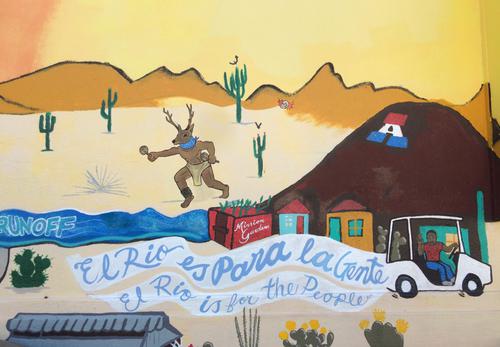当前位置:
X-MOL 学术
›
WIREs Water
›
论文详情
Our official English website, www.x-mol.net, welcomes your
feedback! (Note: you will need to create a separate account there.)
Exposing the myths of household water insecurity in the global north: A critical review
WIREs Water ( IF 6.8 ) Pub Date : 2020-10-04 , DOI: 10.1002/wat2.1486 Katie Meehan 1 , Wendy Jepson 2 , Leila M. Harris 3 , Amber Wutich 4 , Melissa Beresford 5 , Amanda Fencl 2 , Jonathan London 6 , Gregory Pierce 7 , Lucero Radonic 8 , Christian Wells 9 , Nicole J. Wilson 10 , Ellis Adjei Adams 11 , Rachel Arsenault 12 , Alexandra Brewis 4 , Victoria Harrington 2 , Yanna Lambrinidou 13 , Deborah McGregor 12 , Robert Patrick 14 , Benjamin Pauli 15 , Amber L. Pearson 16 , Sameer Shah 17 , Dacotah Splichalova 18 , Cassandra Workman 19 , Sera Young 20
WIREs Water ( IF 6.8 ) Pub Date : 2020-10-04 , DOI: 10.1002/wat2.1486 Katie Meehan 1 , Wendy Jepson 2 , Leila M. Harris 3 , Amber Wutich 4 , Melissa Beresford 5 , Amanda Fencl 2 , Jonathan London 6 , Gregory Pierce 7 , Lucero Radonic 8 , Christian Wells 9 , Nicole J. Wilson 10 , Ellis Adjei Adams 11 , Rachel Arsenault 12 , Alexandra Brewis 4 , Victoria Harrington 2 , Yanna Lambrinidou 13 , Deborah McGregor 12 , Robert Patrick 14 , Benjamin Pauli 15 , Amber L. Pearson 16 , Sameer Shah 17 , Dacotah Splichalova 18 , Cassandra Workman 19 , Sera Young 20
Affiliation

|
Safe and secure water is a cornerstone of modern life in the global North. This article critically examines a set of prevalent myths about household water in high‐income countries, with a focus on Canada and the United States. Taking a relational approach, we argue that household water insecurity is a product of institutionalized structures and power, manifests unevenly through space and time, and is reproduced in places we tend to assume are the most water‐secure in the world. We first briefly introduce “modern water” and the modern infrastructural ideal, a highly influential set of ideas that have shaped household water provision and infrastructure development over the past two centuries. Against this backdrop, we consolidate evidence to disrupt a set of narratives about water in high‐income countries: the notion that water access is universal, clean, affordable, trustworthy, and uniformly or equitably governed. We identify five thematic areas of future research to delineate an agenda for advancing scholarship and action—including challenges of legal and regulatory regimes, the housing‐water nexus, water affordability, and water quality and contamination. Data gaps underpin the experiences of household water insecurity. Taken together, our review of water security for households in high‐income countries provides a conceptual map to direct critical research in this area for the coming years.
中文翻译:

揭露全球北部家庭用水不安全的神话:批判性评论
安全可靠的水是全球北部现代生活的基石。本文主要考察了有关高收入国家家庭用水的一系列神话,重点是加拿大和美国。采取关系方法,我们认为家庭用水不安全是制度化的结构和权力的产物,在时空上不均匀地表现出来,并且在我们倾向于认为是世界上最安全的地方得以复制。我们首先简要介绍“现代水”和现代基础设施的理想,这是一套在过去两个世纪中影响家庭供水和基础设施发展的极具影响力的思想。在这种背景下,我们巩固了证据,破坏了高收入国家关于水的一系列说法:关于水的获取是普遍的,干净,负担得起,值得信赖,并且受到统一或公平的治理。我们确定了未来研究的五个主题领域,以描绘出推进学术和行动的议程-包括法律和监管制度的挑战,住房与水的关系,水的承受能力以及水质和污染。数据缺口是家庭用水不安全经验的基础。综上所述,我们对高收入国家家庭用水安全的评估提供了概念图,可指导未来几年对该领域的关键研究。以及水质和污染。数据缺口是家庭用水不安全经验的基础。综上所述,我们对高收入国家家庭用水安全的评估提供了概念图,可指导未来几年对该领域的关键研究。以及水质和污染。数据缺口是家庭用水不安全经验的基础。综上所述,我们对高收入国家家庭用水安全的评估提供了概念图,可指导未来几年对该领域的关键研究。
更新日期:2020-10-19
中文翻译:

揭露全球北部家庭用水不安全的神话:批判性评论
安全可靠的水是全球北部现代生活的基石。本文主要考察了有关高收入国家家庭用水的一系列神话,重点是加拿大和美国。采取关系方法,我们认为家庭用水不安全是制度化的结构和权力的产物,在时空上不均匀地表现出来,并且在我们倾向于认为是世界上最安全的地方得以复制。我们首先简要介绍“现代水”和现代基础设施的理想,这是一套在过去两个世纪中影响家庭供水和基础设施发展的极具影响力的思想。在这种背景下,我们巩固了证据,破坏了高收入国家关于水的一系列说法:关于水的获取是普遍的,干净,负担得起,值得信赖,并且受到统一或公平的治理。我们确定了未来研究的五个主题领域,以描绘出推进学术和行动的议程-包括法律和监管制度的挑战,住房与水的关系,水的承受能力以及水质和污染。数据缺口是家庭用水不安全经验的基础。综上所述,我们对高收入国家家庭用水安全的评估提供了概念图,可指导未来几年对该领域的关键研究。以及水质和污染。数据缺口是家庭用水不安全经验的基础。综上所述,我们对高收入国家家庭用水安全的评估提供了概念图,可指导未来几年对该领域的关键研究。以及水质和污染。数据缺口是家庭用水不安全经验的基础。综上所述,我们对高收入国家家庭用水安全的评估提供了概念图,可指导未来几年对该领域的关键研究。











































 京公网安备 11010802027423号
京公网安备 11010802027423号